USC Annenberg Inclusion Initiative and WIA present INVISIBLE IN VISUAL EFFECTS
Blockbuster films with stunning visual effects may be one way to draw audiences back to movie theaters. But how many women are responsible for the imagery on screen? According to a new report, the number is very low.

Participants L-R: Dr. Katherine Pieper, Dr. Stacy L. Smith and Marge Dean (Photos via USC/WIA)
The report, titled “Invisible in Visual Effects,” is the second in a partnership between Dr. Stacy L. Smith, the Annenberg Inclusion Initiative and Women in Animation to explore women’s participation across industries. The quantitative study examined women working in visual effects across 400 top-grossing films from 2016 to 2019, focusing on overall prevalence and leadership credits. The study further explored women working in the executive ranks across 60 VFX companies. Finally, awards recognition for women was assessed. The report also includes a qualitative investigation, which consists of 82 in-depth interviews with women in VFX as well as industry decision-makers.
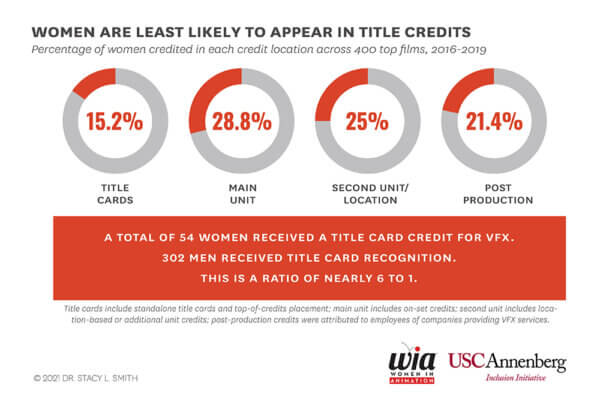
Image via USC/WIA
Across 400 top-grossing films from 2016 to 2019, women received 21.6% of all VFX credits. This is a ratio of 3.6 men to every 1 woman working in VFX. Additionally, there was no change over time, with 20.8% of credits awarded to women in 2016 and 22.6% of credits in 2019.
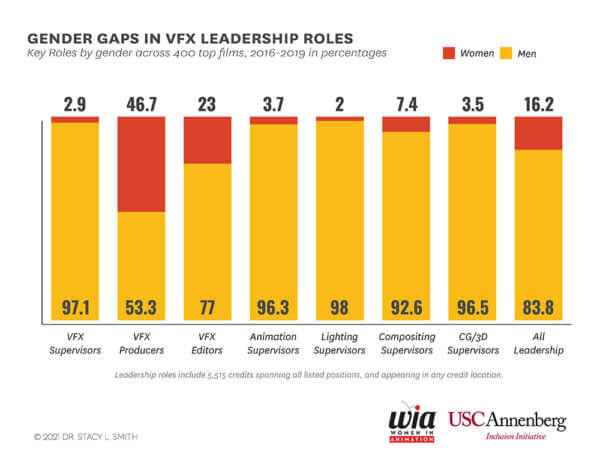
Image via USC/WIA
Turning to leadership roles, women held 16.2% of all senior positions across the 4-year period. This varied by position, however, as women comprised only 2.9% of VFX supervisors but 46.7% of VFX producers. Less than one-quarter (23%) of VFX editors were women, while fewer than 10% of other leadership roles were held by women: Animation supervisors (3.7%), Lighting supervisors (2%), Compositing supervisors (7.4%) and CG/3D Supervisors (3.5%).
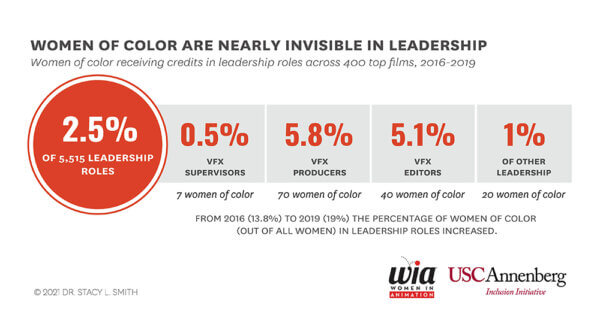
Image via USC/WIA
The study also asked how often women of color held these top positions. The answer? Infrequently. Women of color filled only 2.5% of all leadership roles, and less than 1% of VFX supervisor positions across the sample. This is a ratio of 208 men for every 1 woman of color working as a VFX supervisor. Women of color were most likely to be VFX producers (5.8% of all roles) or VFX editors (5.1% of all roles), but held only 1% of other leadership positions across 400 top films.
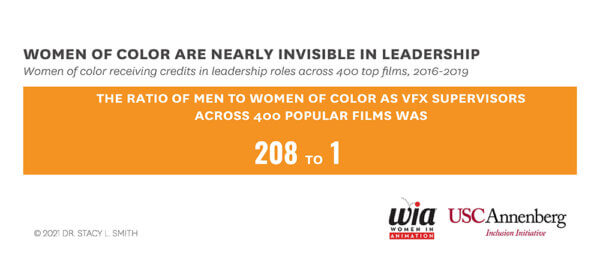
Image via USC/WIA
The lack of women in the visual effects industry is part of a larger pattern of exclusion across the film industry. VFX companies and studios have to think critically about their hiring and promotion practices as well as the cultures they create internally if they want to see more women and in particular women of color ascending to leadership roles.
-Dr. Stacy L. Smith, Associate Professor of Communication/Founder of the Annenberg Inclusion Initiative
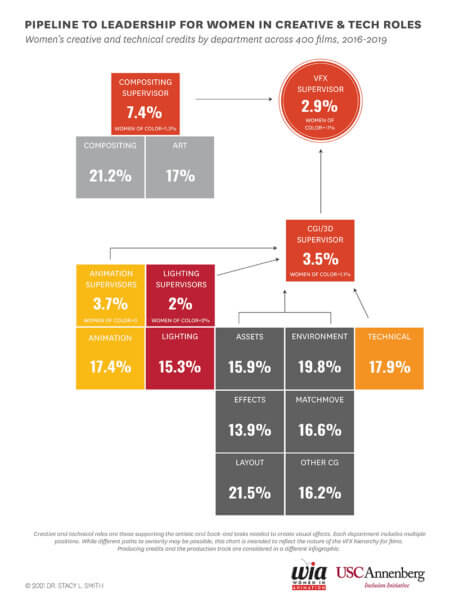
Image via USC/WIA
The study included an examination of the pipeline positions that lead to supervisory roles. The authors note that women fill between 13.9% and 21.5% of pipeline jobs, but these figures plummet to less than 10% of leadership positions.
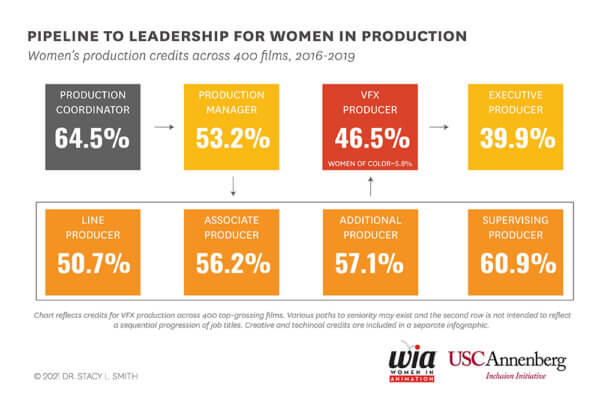
Image via USC/WIA
Even in producing roles, women fill nearly two-thirds of production coordinator roles, but their prevalence drops to less than half of producers. “There are clear leaks and cracks in the pipeline for women across the ecosystem of the VFX industry,” said Dr. Smith.
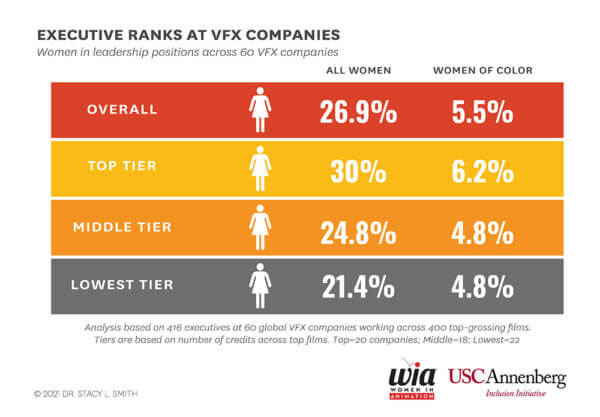
Image via USC/WIA
The report also provides insight into the leadership profile of 60 top VFX companies. The companies were chosen based on their work across top movies. Overall, slightly more than one-quarter (26.9%) of executives at these companies were women, and 5.5% were women of color. Based on frequency of work across top films, the companies were sorted into three tiers. The highest tier of companies, representing 20 organizations, had the highest percentage of women and women of color executives—30% and 6.2%, respectively. Fewer than 25% of executives across the middle (24.8%) and lowest (21.4%) tiers were women, with women of color comprising 4.8% of roles at both tiers.
As the data from this landmark study shows, there are clearly obstacles in place for women in the realm of visual effects. We hope that this fact-based awareness will open more doors and repair broken rungs on the leadership ladder to create a more diverse and inclusive environment in this sector of the entertainment industry.
-WIA President Marge Dean
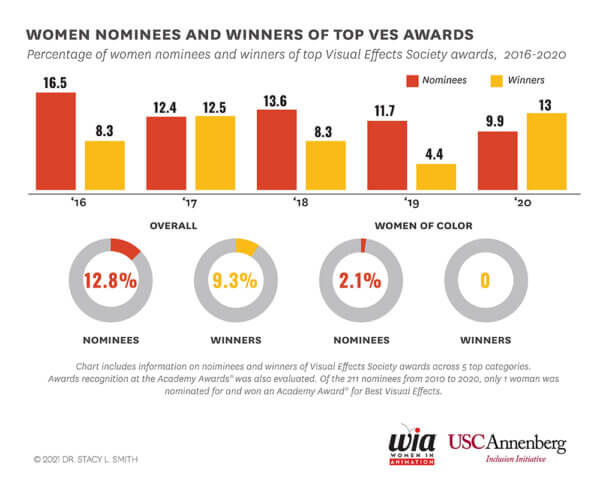
Image via USC/WIA
Another area explored were awards related to visual effects. Only one woman has been nominated for and won an Academy Award for Visual Effects. At the Visual Effects Society Awards, women fared better—12.8% of nominees between 2016 and 2020 and 9.3% of winners. Women of color comprised 2.1% of nominees but none have won an award in the time frame examined.
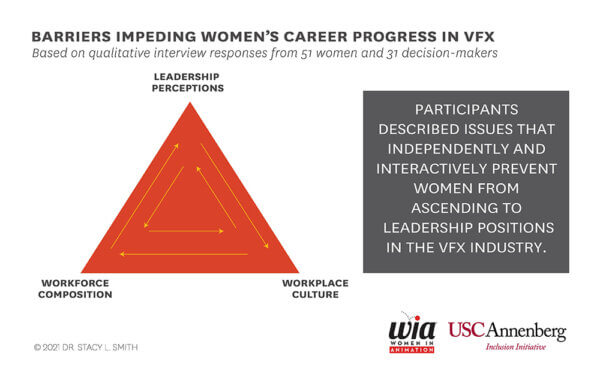
Image via USC/WIA
Results from the qualitative analysis demonstrate the major impediments facing women in the visual effects industry. Responses indicated that three factors contribute independently and interactively to prevent women in VFX from reaching positions of leadership. These include issues related to workforce composition and the prevalence of men in the industry; workplace culture that does not meet women’s needs around work/family balance or encourage their participation; and leadership perceptions that link supervisory roles to masculine traits. The report provides insight as to how these factors may impede women’s careers or encourage them to pursue VFX producer roles which often have less prestige or lower pay.
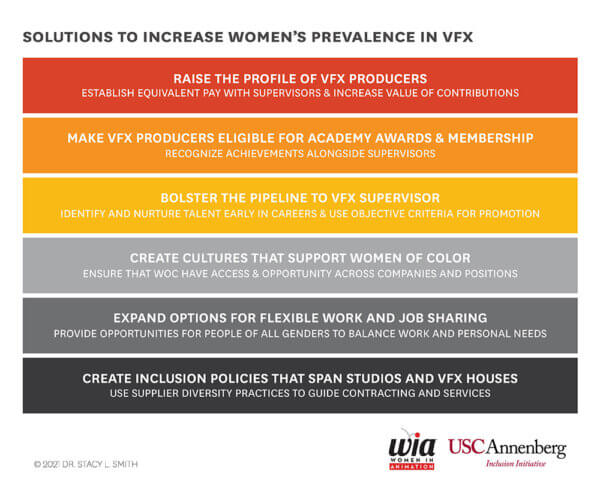
Image via USC/WIA
The report is the latest from the Annenberg Inclusion Initiative, and can be found online here.

